Enhanced Resolution of Martian Polar Stratigraphy via Structure Enhancement Denoising and Sparse Deterministic Deconvolution of SHARAD Data
Highlights
- A two-stage workflow is proposed that synergistically combines Structure Enhancement Denoising (SED) as a pre-processing step with Sparse Deterministic Deconvolution (SDD). This method is shown to be highly effective at suppressing noise while preserving geological structures in SHARAD data.
- A novel method is introduced to determine the optimal regularization parameter (λ) for deconvolution. This is achieved by using the ratio of reflectors extracted from the original noisy radargram versus the structure-enhanced radargram, which provides a robust a priori constraint that outperforms standard L-curve methods on noisy data.
- The workflow provides significantly enhanced vertical resolution of Martian polar stratigraphy, allowing for the resolution of finer-scale layers that were previously obscured by noise or the radar wavelet. This enables the extraction of a more complete and higher-fidelity record of Mars’s past climate history from the North Polar Layered Deposits (NPLD).
- The method is a powerful and broadly applicable tool for improving data from other noisy planetary radar sounders, such as MARSIS on Mars Express or the upcoming RIME instrument on JUICE. Application to the NPLD reveals highly continuous, laterally homogeneous reflectors, reinforcing the “layer cake” depositional model for the region.
Abstract
1. Introduction
2. Data and Method
2.1. Structure Enhancement Denoising (SED) as a Pre-Processing Filter
2.2. Sparse Deterministic Deconvolution (SDD)
3. Results
3.1. Synthetic Model
3.2. SHARAD Radargrams
4. Discussion
4.1. Mechanisms of Performance Improvement
4.2. Potential for Identifying Thinner Beds
4.3. Methodological Considerations, Limitations, and Future Research
4.4. Geological Implications for the NPLD
5. Conclusions
Author Contributions
Funding
Data Availability Statement
Acknowledgments
Conflicts of Interest
References
- Becerra, P.; Byrne, S.; Sori, M.M.; Sutton, S.; Herkenhoff, K.E. Stratigraphy of the north polar layered deposits of Mars from high-resolution topography. J. Geophys. Res. Planets 2016, 121, 1445–1471. [Google Scholar] [CrossRef]
- Fishbaugh, K.E.; Hvidberg, C.S. Martian north polar layered deposits stratigraphy: Implications for accumulation rates and flow. J. Geophys. Res. Planets 2006, 111, E06012. [Google Scholar] [CrossRef]
- Milkovich, S.M.; Head, J.W. North polar cap of Mars: Polar layered deposit characterization and identification of a fundamental climate signal. J. Geophys. Res. Planets 2005, 110, E01005. [Google Scholar] [CrossRef]
- Phillips, R.J.; Zuber, M.T.; Smrekar, S.E.; Mellon, M.T.; Head, J.W.; Tanaka, K.L.; Putzig, N.E.; Milkovich, S.M.; Campbell, B.A.; Plaut, J.J.; et al. Mars north polar deposits: Stratigraphy, age, and geodynamical response. Science 2008, 320, 1182–1185. [Google Scholar] [CrossRef] [PubMed]
- Byrne, S. The polar deposits of Mars. Annu. Rev. Earth Planet. Sci. 2009, 37, 535–560. [Google Scholar] [CrossRef]
- Smith, I.B.; Hayne, P.O.; Byrne, S.; Becerra, P.; Kahre, M.; Calvin, W.; Hvidberg, C.; Milkovich, S.; Buhler, P.; Landis, M.; et al. The Holy Grail: A road map for unlocking the climate record stored within Mars’ polar layered deposits. Planet. Space Sci. 2020, 184, 104841. [Google Scholar] [CrossRef]
- Head, J.W.; Mustard, J.F.; Kreslavsky, M.A.; Milliken, R.E.; Marchant, D.R. Recent ice ages on Mars. Nature 2003, 426, 797–802. [Google Scholar] [CrossRef]
- Smith, I.B. A retrospective on Mars polar ice and climate. In Oxford Research Encyclopedia of Planetary Science; Oxford University Press: Oxford, UK, 2022. [Google Scholar]
- Plaut, J.J.; Picardi, G.; Safaeinili, A.; Ivanov, A.B.; Milkovich, S.M.; Cicchetti, A.; Kofman, W.; Mouginot, J.; Farrell, W.M.; Phillips, R.J.; et al. Subsurface radar sounding of the south polar layered deposits of Mars. Science 2007, 316, 92–95. [Google Scholar] [CrossRef] [PubMed]
- Lalich, D.E.; Holt, J.W. New Martian climate constraints from radar reflectivity within the north polar layered deposits. Geophys. Res. Lett. 2017, 44, 657–664. [Google Scholar] [CrossRef]
- Lalich, D.E.; Holt, J.W.; Smith, I.B. Radar reflectivity as a proxy for the dust content of individual layers in the Martian north polar layered deposits. J. Geophys. Res. Planets 2019, 124, 1690–1703. [Google Scholar] [CrossRef]
- Seu, R.; Phillips, R.J.; Biccari, D.; Orosei, R.; Masdea, A.; Picardi, G.; Safaeinili, A.; Campbell, B.A.; Plaut, J.J.; Marinangeli, L.; et al. SHARAD sounding radar on the Mars Reconnaissance Orbiter. J. Geophys. Res. Planets 2007, 112, E05S05. [Google Scholar] [CrossRef]
- Croci, R.; Seu, R.; Flamini, E.; Russo, E. The SHAllow RADar (SHARAD) onboard the NASA MRO mission. Proc. IEEE 2011, 99, 794–807. [Google Scholar] [CrossRef]
- Campbell, B.; Phillips, R. Mars Reconnaissance Orbiter Shallow Radar Radargram Data; MRO-M-SHARAD-5-RADARGRAM-V1.0; NASA Planetary Data System: Washington, DC, USA, 2014. [Google Scholar] [CrossRef]
- Campbell, B.A.; Watters, T.R.; Morgan, G.A. Dielectric properties of the Medusae Fossae Formation and implications for ice content. J. Geophys. Res. Planets 2021, 126, e2020JE006601. [Google Scholar] [CrossRef]
- Lauro, S.E.; Mattei, E.; Soldovieri, F.; Pettinelli, E.; Orosei, R.; Vannaroni, G. Dielectric constant estimation of the uppermost Basal Unit layer in the martian Boreales Scopuli region. Icarus 2012, 219, 458–467. [Google Scholar] [CrossRef]
- Fang, P.; Miao, Z.; Zhang, J. Sparse deterministic deconvolution of Mars SHARAD data. IEEE T Geosci. Remote 2024, 62, 5102313. [Google Scholar] [CrossRef]
- Campbell, B.A.; Morgan, G.A.; Bernardini, F.; Putzig, N.E.; Nunes, D.C.; Plaut, J.J. Calibration of Mars Reconnaissance Orbiter Shallow Radar (SHARAD) data for subsurface probing and surface reflectivity studies. Icarus 2021, 360, 114358. [Google Scholar] [CrossRef]
- Whitten, J.L.; Campbell, B.A. Lateral continuity of layering in the Mars South Polar Layered Deposits from SHARAD sounding data. J. Geophys. Res. Planets 2018, 123, 1541–1554. [Google Scholar] [CrossRef]
- Fang, P.; Zhang, J. Recursive enhancement of weak subsurface boundaries and its application to SHARAD data. Remote Sens. 2022, 14, 1525. [Google Scholar] [CrossRef]
- Knaus, C.; Zwicker, M. Progressive image denoising. IEEE Trans. Image Process 2014, 23, 3114–3125. [Google Scholar] [CrossRef]
- Fang, P.; Zhang, J. Phase-congruency reflector detection of orbital radar data via shearlet transform on Shannon-Gabor wavelet. IEEE Trans. Geosci. Remote Sens. 2024, 62, 5110413. [Google Scholar] [CrossRef]
- Xiong, S.; Muller, J.P. Automated reconstruction of subsurface interfaces in Promethei Lingula near the Martian south pole by using SHARAD data. Planet. Space Sci. 2019, 166, 59–69. [Google Scholar] [CrossRef]
- Liu, X.F.; Fa, W.Z. A fully automatic algorithm for reflector detection in radargrams based on continuous wavelet transform and minimum spanning tree. IEEE Trans. Geosci. Remote Sens. 2022, 60, 4601620. [Google Scholar] [CrossRef]
- Ferro, A.; Bruzzone, L. Automatic extraction and analysis of ice layering in radar sounder data. IEEE Trans. Geosci. Remote Sens. 2013, 51, 1622–1634. [Google Scholar] [CrossRef]
- Wang, L.; Zhao, Q.; Gao, J.; Xu, Z.; Fehler, M.; Jiang, X. Seismic sparse-spike deconvolution via Toeplitz-sparse matrix factorization. Geophysics 2016, 81, V169–V182. [Google Scholar] [CrossRef]
- Turner, G. Subsurface radar propagation deconvolution. Geophysics 1994, 59, 215–223. [Google Scholar] [CrossRef]
- Schmelzbach, C.; Huber, E. Efficient deconvolution of ground-penetrating radar data. IEEE Trans. Geosci. Remote Sens. 2015, 53, 5209–5217. [Google Scholar] [CrossRef]
- Boyd, S.; Boyd, S.P.; Vandenberghe, L. Convex Optimization; Cambridge University Press: Cambridge, UK, 2004. [Google Scholar]
- Boyd, S.; Parikh, N.; Chu, E.; Peleato, B.; Eckstein, J.J.F. Distributed optimization and statistical learning via the alternating direction method of multipliers. Found. Trends Mach. Learn. 2011, 3, 1–122. [Google Scholar] [CrossRef]
- Fodor, I.K. Denoising through wavelet shrinkage: An empirical study. J. Electron. Imaging 2003, 12, 151–160. [Google Scholar] [CrossRef]
- Chen, G.; Qian, S.-E. Denoising of hyperspectral imagery using principal component analysis and wavelet shrinkage. IEEE Trans. Geosci. Remote Sens. 2011, 49, 973–980. [Google Scholar] [CrossRef]
- Fang, P.; Zhang, J. Unveiling subtle structures of Martian north polar layered deposits by efficient deconvolution of SHARAD sounder data. In Proceedings of the 55th Lunar and Planetary Science Conference, The Woodlands, TX, USA, 11–15 March 2024; Volume 3040, p. 1125. [Google Scholar]
- Bruzzone, L.; Plaut, J.J.; Alberti, G.; Blankenship, D.D.; Bovolo, F.; Campbell, B.A.; Ferro, A.; Gim, Y.; Kofman, W.; Komatsu, G. RIME: Radar for icy moon exploration. In Proceedings of the 2013 IEEE International Geoscience and Remote Sensing Symposium-IGARSS, Melbourne, Australia, 21–26 July 2013; pp. 3907–3910. [Google Scholar]
- Kolb, E. Geologic history of the polar regions of Mars based on Mars Global Surveyor data II. Amazonian Period. Icarus 2001, 154, 22–39. [Google Scholar] [CrossRef]
- Milkovich, S.M.; Plaut, J.J. Martian south polar layered deposit stratigraphy and implications for accumulation history. J. Geophys. Res. Planets 2008, 113, E6. [Google Scholar] [CrossRef]
- Fang, P.; Zhang, J. New insights into composition variation of Mars south polar layered deposits from SHARAD radar sounder. J. Geophys. Res. 2023, 128, e2023JE007812. [Google Scholar] [CrossRef]
- Grima, C.; Kofman, W.; Mouginot, J.; Phillips, R.J.; Herique, A.; Biccari, D.; Seu, R.; Cutigni, M. North polar deposits of Mars: Extreme purity of the water ice. Geophys. Res. Lett. 2009, 36, L03203. [Google Scholar] [CrossRef]
- Phillips, R.J.; Davis, B.J.; Tanaka, K.L.; Byrne, S.; Mellon, M.T.; Putzig, N.E.; Haberle, R.M.; Kahre, M.A.; Campbell, B.A.; Carter, L.M.; et al. Massive CO2 ice deposits sequestered in the south polar layered deposits of Mars. Science 2011, 332, 838–841. [Google Scholar] [CrossRef] [PubMed]
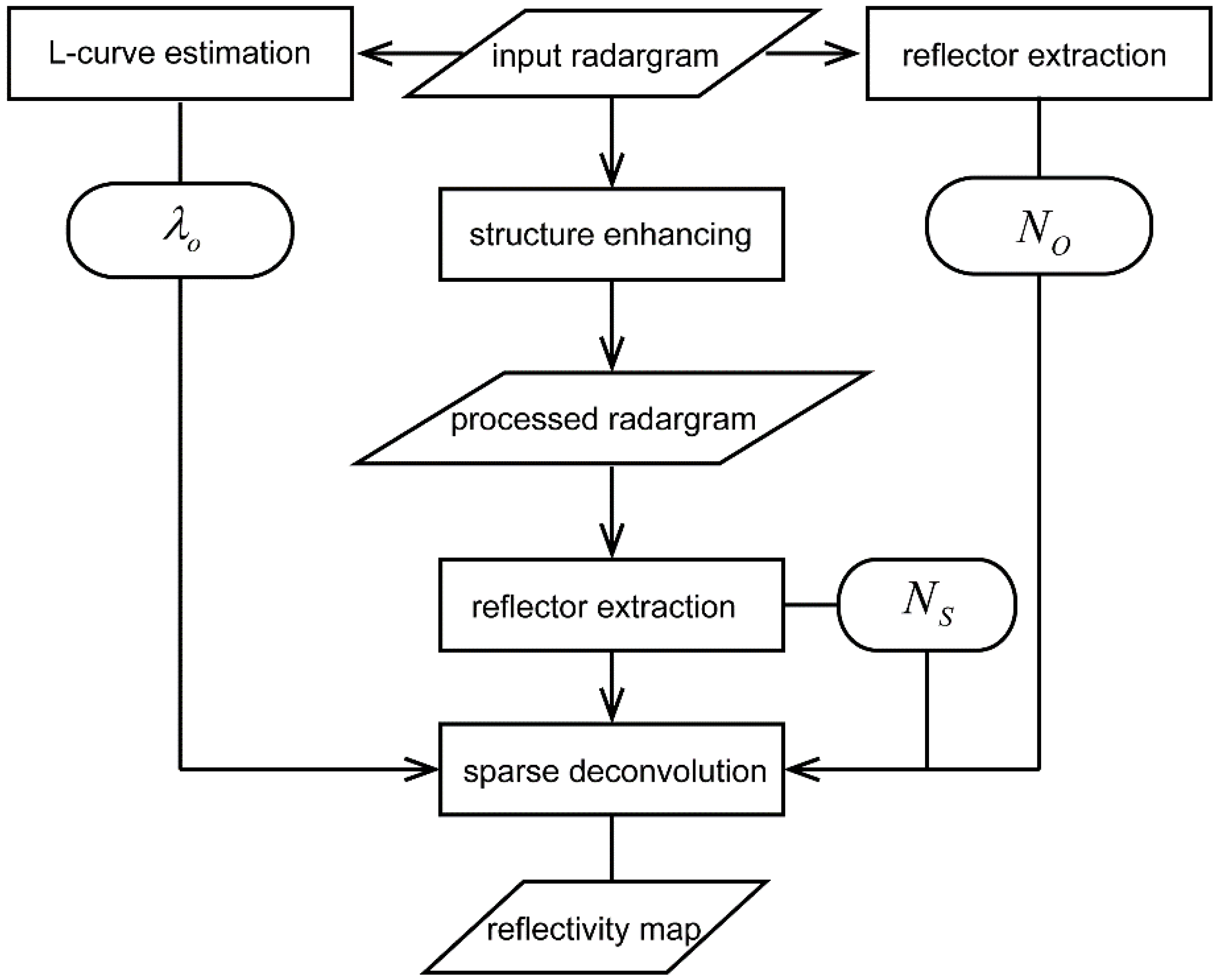
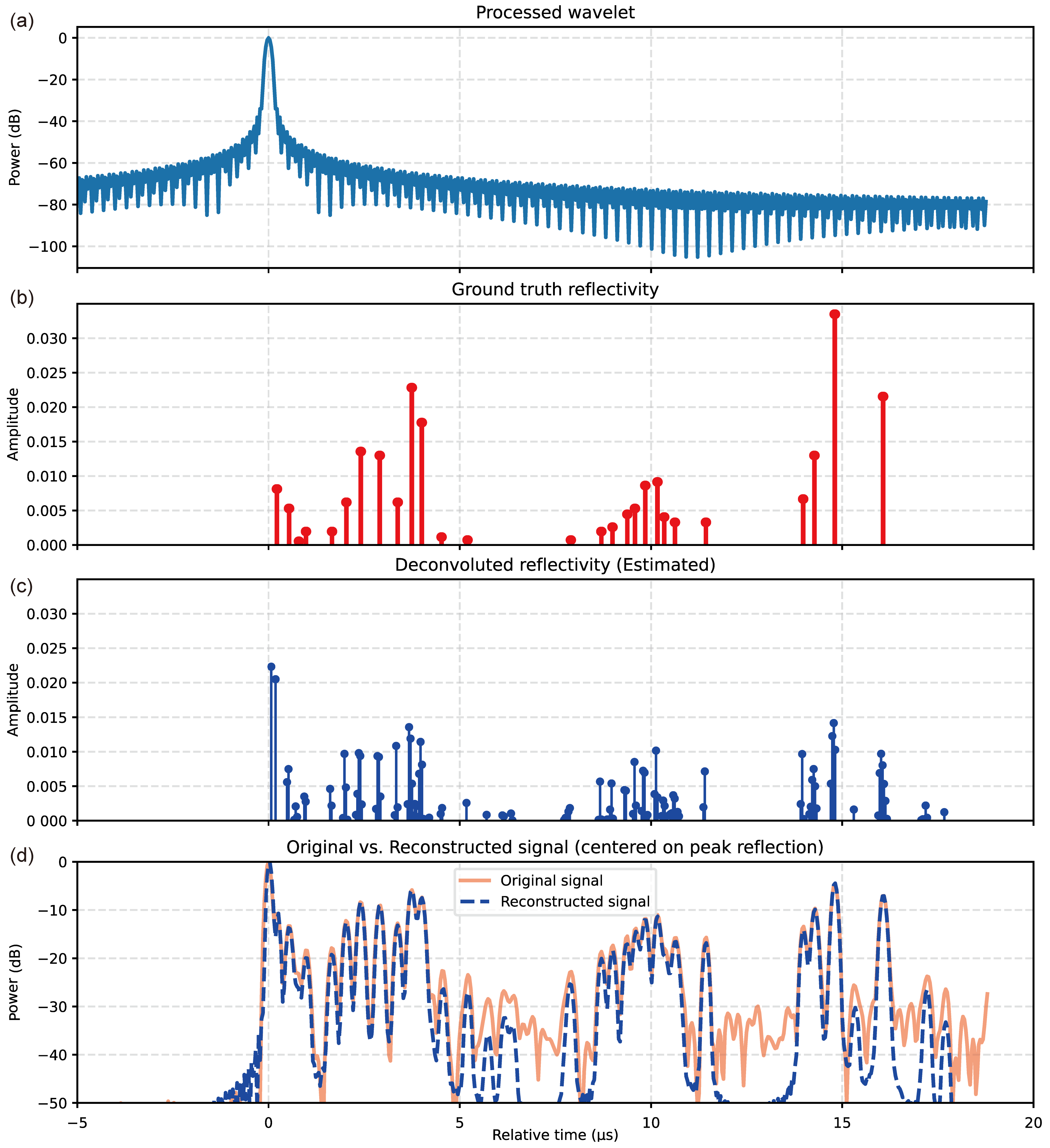
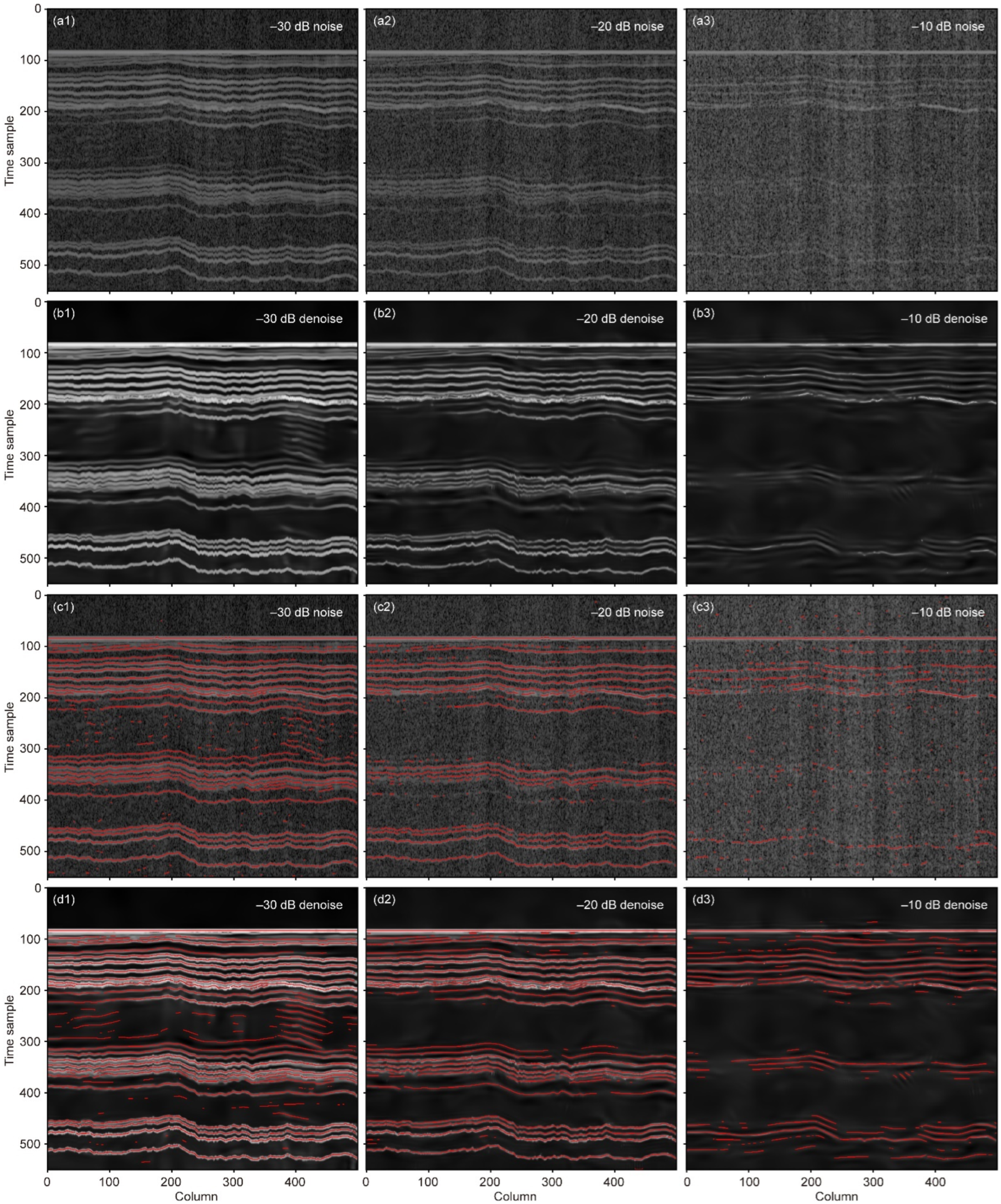
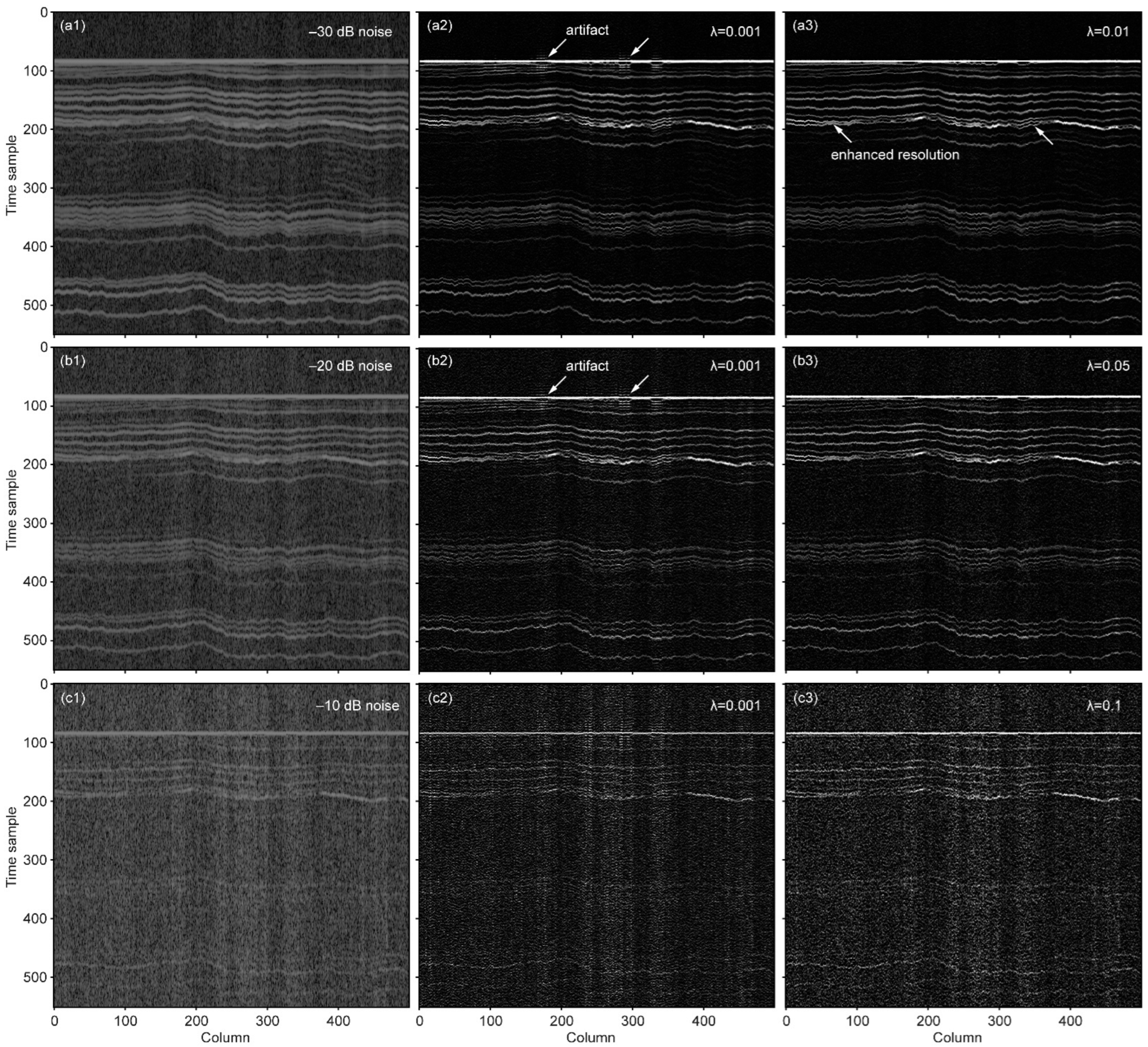

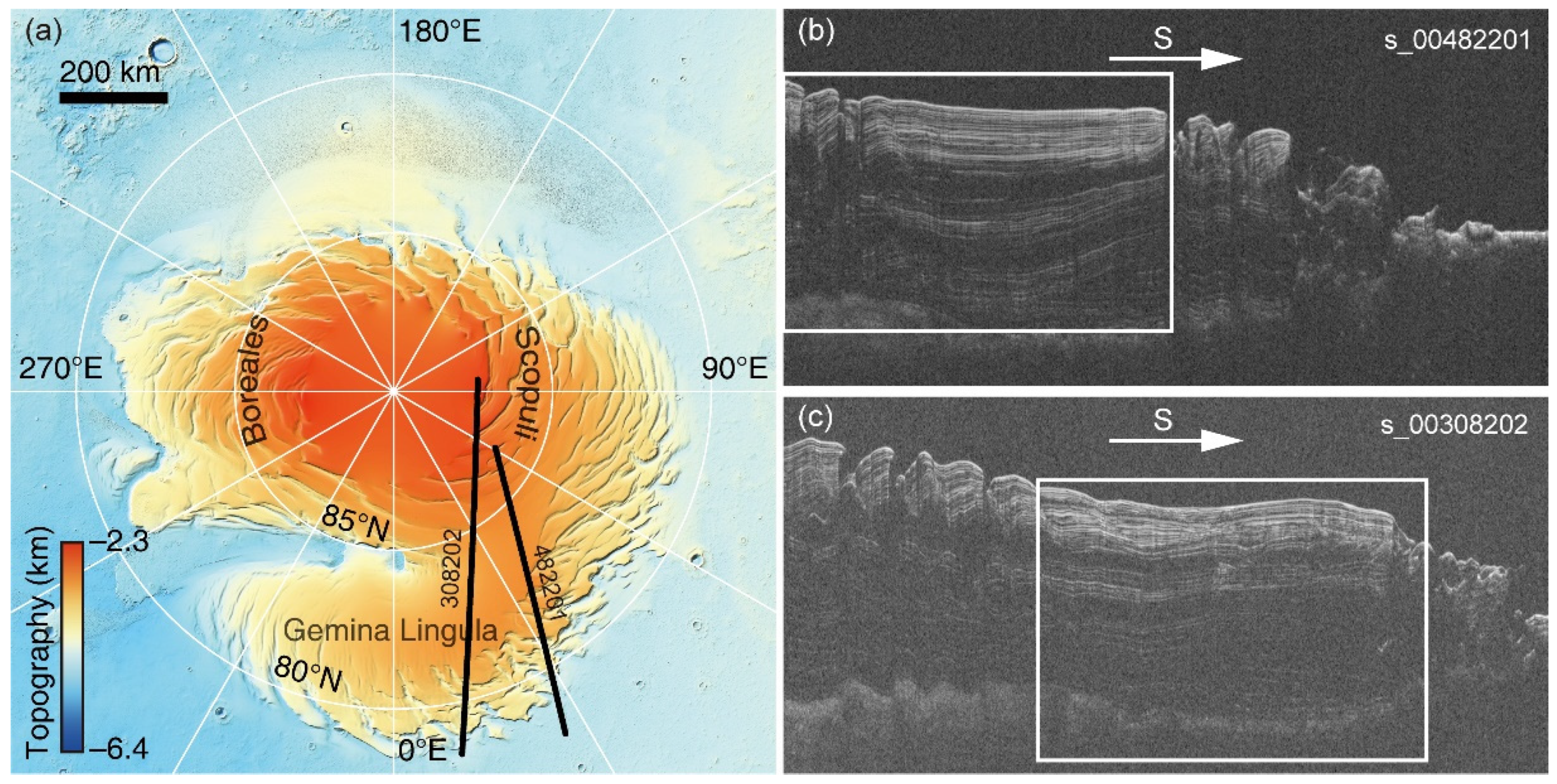
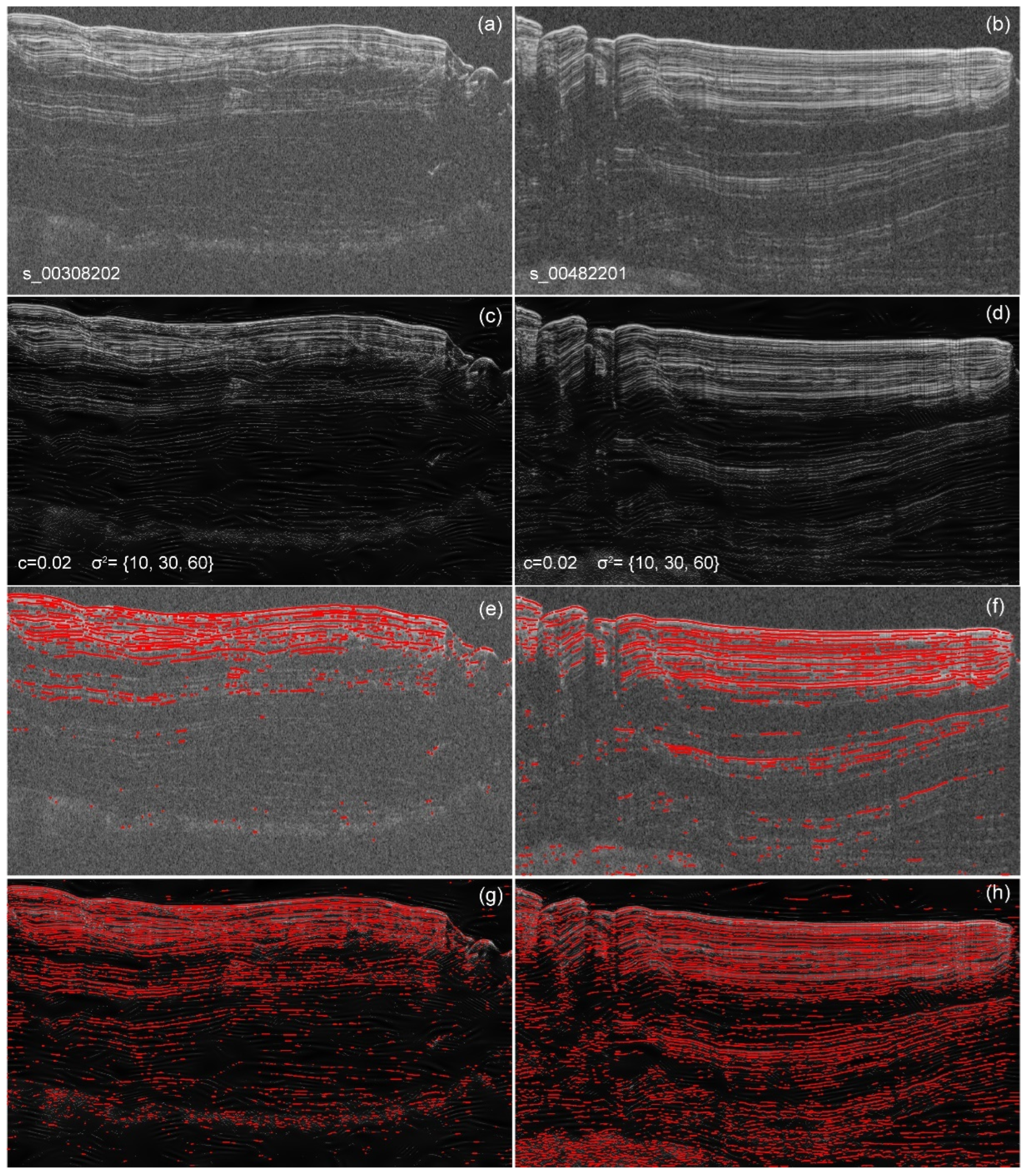
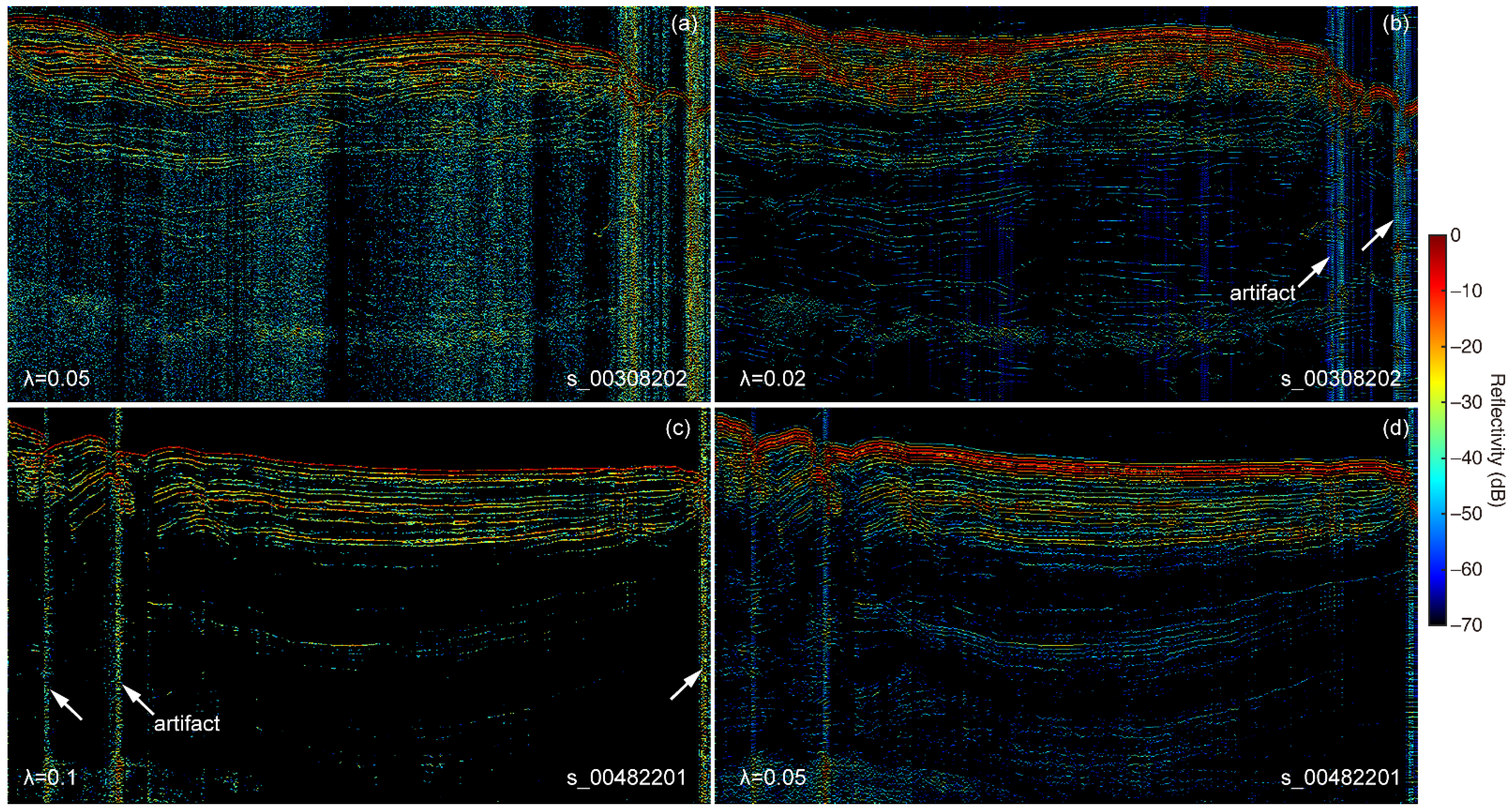
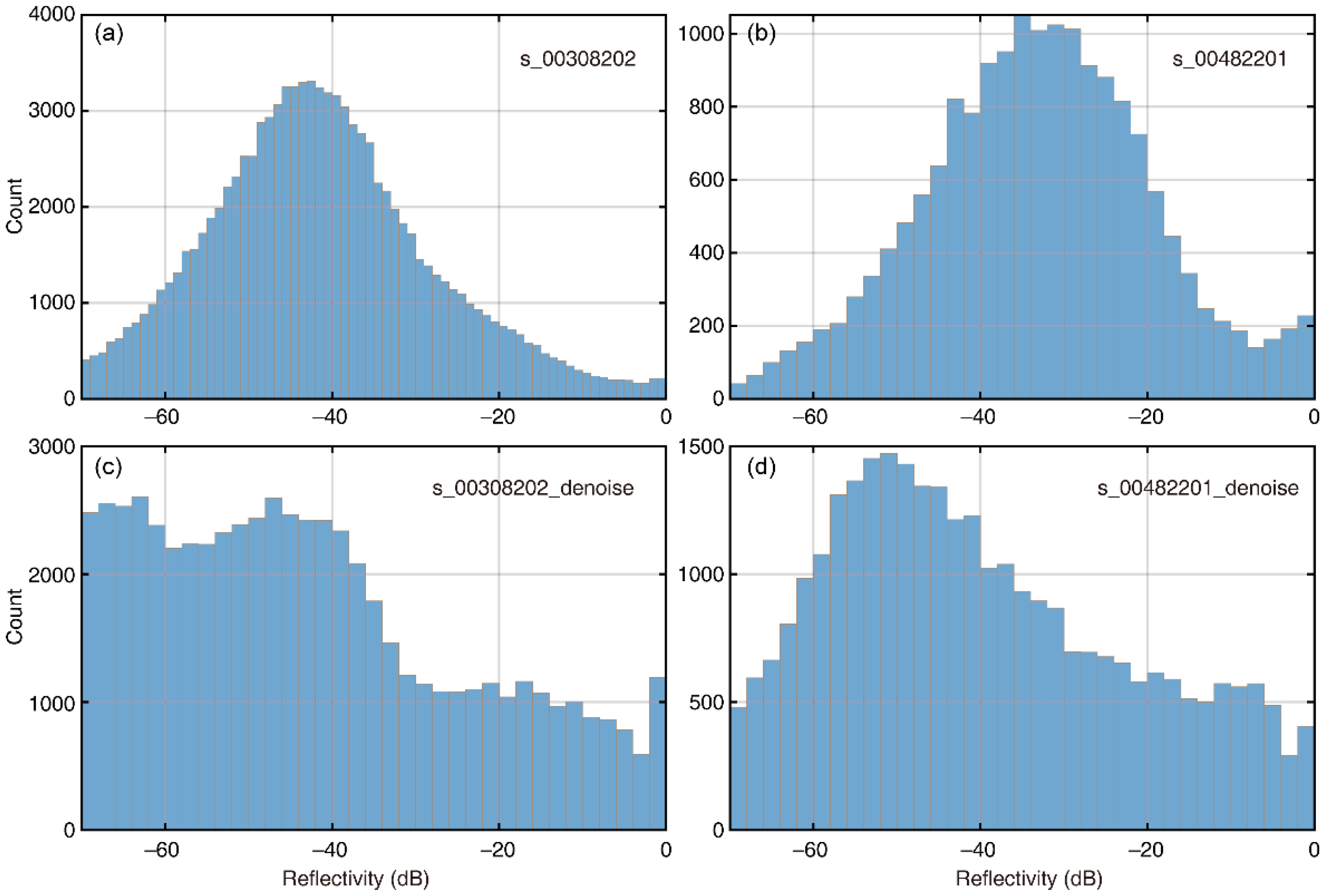
Disclaimer/Publisher’s Note: The statements, opinions and data contained in all publications are solely those of the individual author(s) and contributor(s) and not of MDPI and/or the editor(s). MDPI and/or the editor(s) disclaim responsibility for any injury to people or property resulting from any ideas, methods, instructions or products referred to in the content. |
© 2025 by the authors. Licensee MDPI, Basel, Switzerland. This article is an open access article distributed under the terms and conditions of the Creative Commons Attribution (CC BY) license (https://creativecommons.org/licenses/by/4.0/).
Share and Cite
Fang, P.; Zhang, J. Enhanced Resolution of Martian Polar Stratigraphy via Structure Enhancement Denoising and Sparse Deterministic Deconvolution of SHARAD Data. Remote Sens. 2025, 17, 3783. https://doi.org/10.3390/rs17233783
Fang P, Zhang J. Enhanced Resolution of Martian Polar Stratigraphy via Structure Enhancement Denoising and Sparse Deterministic Deconvolution of SHARAD Data. Remote Sensing. 2025; 17(23):3783. https://doi.org/10.3390/rs17233783
Chicago/Turabian StyleFang, Peng, and Jinhai Zhang. 2025. "Enhanced Resolution of Martian Polar Stratigraphy via Structure Enhancement Denoising and Sparse Deterministic Deconvolution of SHARAD Data" Remote Sensing 17, no. 23: 3783. https://doi.org/10.3390/rs17233783
APA StyleFang, P., & Zhang, J. (2025). Enhanced Resolution of Martian Polar Stratigraphy via Structure Enhancement Denoising and Sparse Deterministic Deconvolution of SHARAD Data. Remote Sensing, 17(23), 3783. https://doi.org/10.3390/rs17233783







